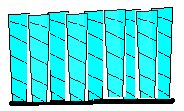Landlord's Guide to Replacing Carpet & Flooring
Best Carpet Selection for Rental Property?
It's important that you know something about carpet fibers and have some knowledge of the different carpet styles available. It's the only way to narrow your possibilities. The next decision you need to make, is what grade of carpet to buy? Well, this decision might depend on how much money you have to spend on your project. It might be wise to consider the type of tenant you cater to. Do you allow pets? How long does your typical tenant stay? These are the simple questions.
Here is a general rule of thumb about what grade of carpet to buy, depending on your individual application. Please remember that this is only a general guideline and is subject to your final financial goals. You can reduce the cost of carpet and flooring replacements if you choose wisely.
What makes one carpet better than another?
Generally, carpet is graded by the materials used, the amount of fiber weight and how well it is constructed. Without going into great detail with this, because I want to make it simple for you. Lets narrow it down to fiber, density and twist.
Fiber Choice
As far as fibers go, a standard nylon is the best choice for those who want a long-lasting carpet. It is very durable, cleans easy and tolerates heavy foot-traffic better than all other synthetic fibers. It is the most expensive fiber too. A good choice for living rooms, family rooms, hallways and stairs.
Polyester is one of the least expensive fibers. A thick polyester carpet may look great and feel soft initially, but it is prone to matting and crushing of the pile. Therefore polyester doesn't do well in medium to heavy foot traffic areas. It is alright to choose polyester as long as you don't have high expectations. A good choice for bedrooms and other low-traffic applications
Olefin is a strong fiber generally used to make inexpensive looped Berber styles. The cost is reasonable but Olefin is an oily fiber that attracts dirt and doesn't clean easily. Berbers with smaller loops tend to perform better. Looped Berbers snag easily and is not a good choice for active kids or pets. Consider a Frieze style or a "California Berber" Style, as these have no loops.
Pile Density
(Number of tufts per square inch)
How thick the fibers are and how tightly packed together they are will determine the pile density. Think of it like a densely wooded forest where the trees are thick and close together. The thicker the better, the heavier the better. Dig your fingers into the pile of the carpet. Are the fibers tightly packed and thick or are your nails digging into the backing of the carpet. Thin threadbare carpets are less expensive, thick plush carpets are more expensive. It's not rocket science.
Lower Density
Higher Density
Tuft Twist
(Number of twists per lineal inch of tuft)
Next check the fiber twist. With plush styles of carpets, the tufts of fibers are twisted in the same way that people curl their hair. The carpet fibers are grouped together into tufts and twisted while heat is applied to "set" the fibers permanently. The tighter the fibers are twisted, the longer your carpet will look like new.
Tufts twisted 5 times (good)
Tufts twisted 7 times (better)
Next:





